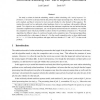174 search results - page 12 / 35 » A new objective function for sequence labeling |
103
click to vote
JCO
2007
14 years 11 months ago
2007
We study a variant of classical scheduling, which is called scheduling with “end of sequence” information. It is known in advance that the last job has the longest processing ...
JCT
2010
14 years 10 months ago
2010
Abstract. We present bijections between four classes of combinatorial objects. Two of them, the class of unlabeled (2 + 2)-free posets and a certain class of involutions (or chord ...
PAMI
2007
14 years 11 months ago
2007
—We present a novel convex programming scheme to solve matching problems, focusing on the challenging problem of matching in a large search range and with cluttered background. M...
107
click to vote
TCSV
2002
14 years 11 months ago
2002
The new video-coding standard MPEG-4 enables content-based functionality, as well as high coding efficiency, by taking into account shape information of moving objects. A novel alg...
136
click to vote
CP
2003
Springer
15 years 5 months ago
2003
Springer
Multiple sequence alignment is a central problem in Bioinformatics. A known integer programming approach is to apply branch-and-cut to exponentially large graph-theoretic models. T...

